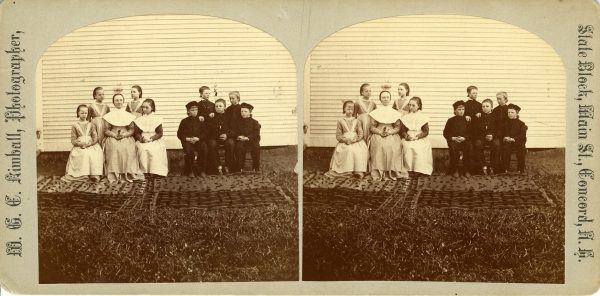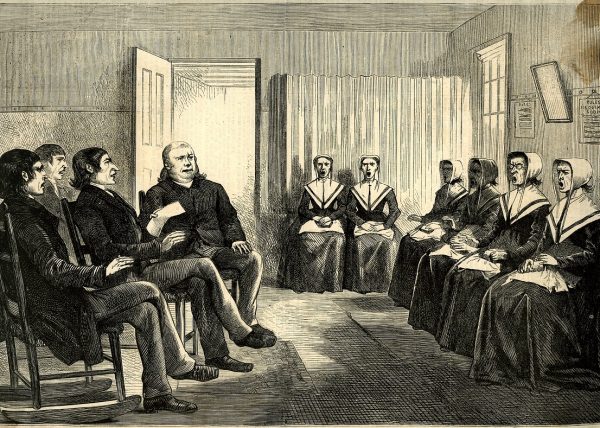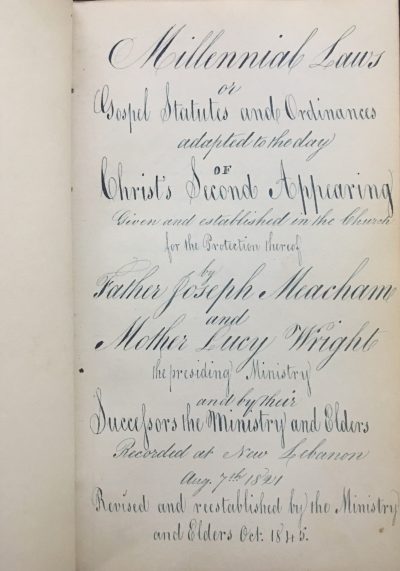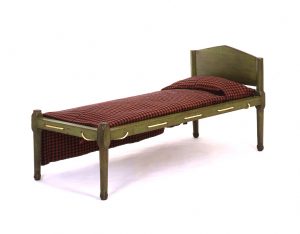In 1784, just ten short years after establishing themselves in America, the United Society of Believers in Christ’s Second Appearing lost their founder. Although many feared the death of Mother Ann Lee would result in the end of the Shaker faith, her successors not only carried on the gospel, but made it thrive. Father Joseph Meacham, the first American convert to obtain a position of leadership, decided in the late 1780s that the only way for Shakers to live a life fully dedicated to simplicity and perfection was to withdraw from society and create their own communities. These communities would be self-sufficient and isolated to outside influences, allowing the Shakers to live a pure existence free from the evils of “the World.” Under Father Joseph’s leadership, eleven different societies were formed across five different states. The distance between these societies, however, made it difficult to promote uniformity amongst all Believers, and many individuals began seeking a codified system of rules to promote order amongst the various communities. This eventually led to the creation of the Millennial Laws.
Essentially, the Millennial Laws were rules to live by which also helped establish clear lines between Shakers and the World. They provided guidance and orders to Believers on nearly all aspects of everyday life: how to worship, how to conduct temporal business, and how to interact with other Believers, among others. The first list of rules was compiled by Brother Freegift Wells in early 1821 and was given to Mother Lucy Wright, the current leader of the Shaker’s body of leadership known as the Ministry, with the suggestion that it be published and spread throughout the communities. Thinking that wide distribution of these orders would not only make them less sacred, but would limit the ability of future Ministry officials to revise rules when needed, Mother Lucy refused. Regardless, after her death later that same year, the first copy of the Millennial Laws was printed and distributed.
Separation from the World
One very important use of the Millennial Laws was to create strict boundaries between Shakers and the outside World. Believers were intent on living their lives as self-sufficient and pure as they possibly could, and a key element in being successful was maintaining a distance from the non-Believers outside their communities. For instance, the Millennial Laws forbade Shakers from going out into the World without first obtaining permission from their respective Elders. If they did receive permission to travel, they were forbidden to enter museums or theaters, to read unapproved literature, or to even let a non-Believer pass between two Shakers when walking on the street. When they returned from their trip, they were required to give a full account of their travels to the Elders and were not allowed to enter any worship meetings until they had done so.
Other rules, such as forbidding the use of “worldly titles” like “Miss” or “Mister,” or rules restricting the dress of Brothers and Sisters, were also used to separate Believers from the outside. This was not done solely to isolate the communities, although it did have that affect, but it was also a way to promote unity among the distant societies. With these rules in place, the central Ministry, located at Mount Lebanon in New York, could be reassured that all Believers across the country were living their daily lives in a manner that was consistent, regardless of the large distances separating the villages.
Separating the Sexes
As one of the central tenants of Shaker faith, celibacy and proper interaction between the sexes had always been a vital concern to devout Believers. In an effort to not “excite lustful temptations,” the Millennial Laws provided orders which made clear what was expected of both Brothers and Sisters when it came to maintaining appropriate conduct. All Believers were forbidden to send or receive letters, within the community or to the outside, without first showing the contents to their Elders. The Millennial Laws deemed it inappropriate for Brothers and Sisters to pass one another on the stairs, to converse with each other at length on subjects not vitally important, to enter one another’s shops or apartments, or to work together without an Elder’s permission. When a Brother or Sister had any need to consult with an Elder, they were required to see “each sex in their own order,” meaning a Brother had to see a male Elder, and Sisters had to see a female Eldress.

Even as children, Brothers and Sisters were kept separate. Young boys and girls alternated school seasons and were rarely seen working together.
Although rules were strict, the Ministry understood that Brothers and Sisters had to interact some times to keep everyone united in each society. For this reason, Union Meetings were regularly conducted through the 1860s. During Union Meeting, Brothers and Sisters were allowed to gather in one room to talk amongst themselves about general topics. These meetings were still heavily regulated: Brothers and Sisters had to sit on opposite sides of the room with at least five feet between them, no whispering or “blinking” was to be done, no cologne or perfume could be worn, and if anyone had reason to miss their assigned meeting, they had to consult with an Elder.

Although different from Union Meetings, Singing Meetings were an additional worship service with smaller groups of Brothers and Sisters. The separation of sexes was still strictly enforced.
While all these rules may seem overbearing to us today, it is important to remember the context in which these rules were created. Living a celibate life was not easy for everyone, and these rules were a way to help remove temptation from everyday life and ensure that all Believers were staying true to the lifestyle Shakers were expected to lead.
The Smart and the Strange
In addition to rules that were designed to help separate Believers from the World and those that separated Brothers from Sisters, the Millennial Laws contained a variety of other orders that governed everyday life. These rules told Shakers how to dress, when to eat, how to speak, and more. Many of these rules served an obvious, practical purpose. For example, each edition of the Millennial Laws contains a section on “Orders to Prevent Loss by Fire” which discouraged carrying open flames out in courtyards or into barns and other enclosed spaces. This section also admonished smoking, improperly disposing ashes, and leaving a lit stove open and unattended. Rules such as these served to protect communities from disaster. The Millennial Laws also advise Believers to not run into debt with the World or to purchase items they could readily get in their own communities. These rules were put in place to keep Shaker communities as self-sufficient as possible.
Some rules in the Millennial Laws are a little harder to understand. They contained rules against keeping any animals as pets or giving any animals Christian names. In 1845 it was proclaimed that all beds should be painted green and that all curtains should be of a “modest color” but not “red, checked, striped or flowered,” and, up until the 1860s, Shakers were forbidden to eat raw fruit or nuts before breakfast or after 6 o’clock, cucumbers were not to be eaten unless seasoned with salt and pepper, and it was considered “unwholesome” if bread was eaten the same day it was made.
Many of these strange rules were given with no written explanation, which makes explaining and understanding them hard to do. We do know that beds were painted green to create uniformity among communities—no matter what community you were in you could expect to find common features. We also know that Shakers were not allowed to have pets for the same reason they were not allowed to have children: Believers were expected to love everyone and everything equally, and having a child meant you cared for one person more than others. The same could be said for having a pet that you took care of more closely than the rest of the animals. Other rules, however, are not as easy to understand without knowing how or why they came about.
Rules or Suggestions?
Today, there are three main versions of the Millennial Laws: the original 1821 edition, and 1845 edition, and an 1860 edition. Despite a final reworking of the laws in 1887 and a number of supplemental rule books created by devout Shakers, these three editions remain the most prevalent. Of these three editions, the 1845 version is the most widely known and referenced. The fervor of the religious revival known as the Era of Manifestations plays a large part in the importance of the set of laws. It is possible the 1845 edition was created in an attempt to calm the religious zeal at the height of the revival. Others suggest the revisions in 1845 were inspired by the spiritual gifts and visions being received by “Instruments” (Shakers who had a connection to the spirit world). Regardless of the reason, it is obvious why the 1845 Millennial Laws are the most widespread and talked about. This comprehensive edition contains almost 400 rules and orders for Believers to follow. That is twice as many rules as the original version in 1821 and three times the amount of rules found in 1860.
Even with the great number of rules to follow, the Millennial Laws really were not heavily enforced. The Mount Lebanon community and those near it were most likely to adhere to each rule, but the further West you went, the less likely you were to see the rules in full effect. As the years passed and communities began to shrink in size, the Millennial Laws were all but a thing of the past. While Shakers still clung to the most important rules, like regularly confessing their sins and practicing celibacy, they became less strict about having pets or the types of clothing people wore and other rules that were no longer seen as important. However, the Millennial Laws serve as an interesting insight into the way Shakers were expected to live their lives in the 19th century.
Sources
Brewer, Priscilla J. Shaker Communities, Shaker Lives. Hanover, NH: University Press of New England, 1986.
Johnson, Theodore E., ed. “Rules and Orders for the Church of Christ’s Second Appearing. Established by the Ministry and Elders of the Church. Revised and Reestablished by the Same. New Lebanon, New York, May 1860.” Shaker Quarterly 11, no. 4 (Winter 1971): 139-165.
Johnson, Theodore E., ed. “The ‘Millennial Laws’ of 1821.” Shaker Quarterly 7, no. 2 (Summer 1967): 35-58.
Millennial Laws or Gospel Statutes and Ordinances adapted to the day of Christ’s Second Appearing. Given and established in the Church for the Protection thereof by Father Joseph Meacham and Mother Lucy Wright, the presiding Ministry, and by their Successors the Ministry and Elders. Recorded at New Lebanon, Aug. 7th 1821. Revised and reestablished by the Ministry and Elders Oct. 1845. Manuscript. Hancock Shaker Village, Pittsfield, MA.
Pearson, Elmer R. and Julia Neal. The Shaker Image, Second and Annotated Edition. Pittsfield, MA: Hancock Shaker Village, Inc., 1995.



